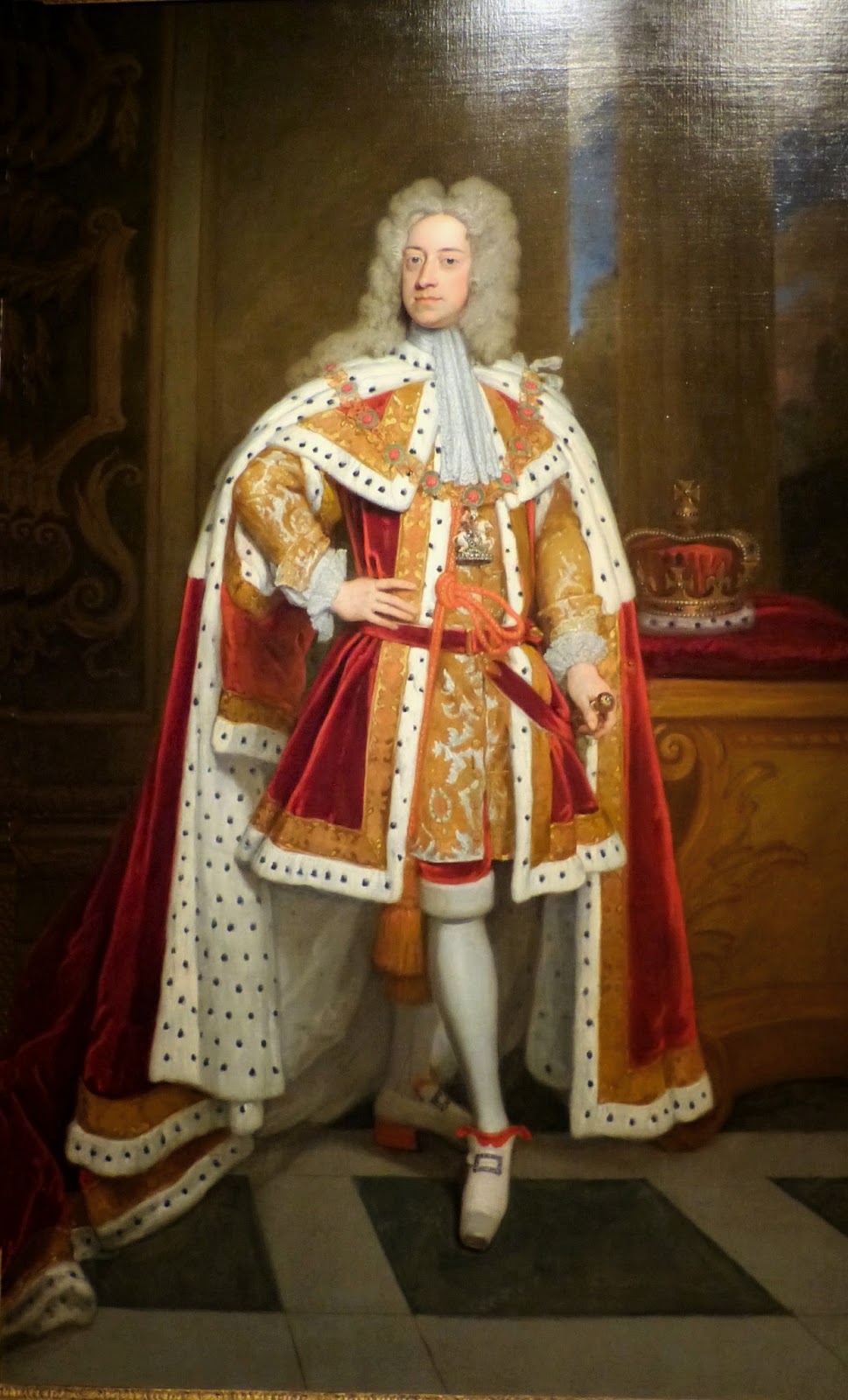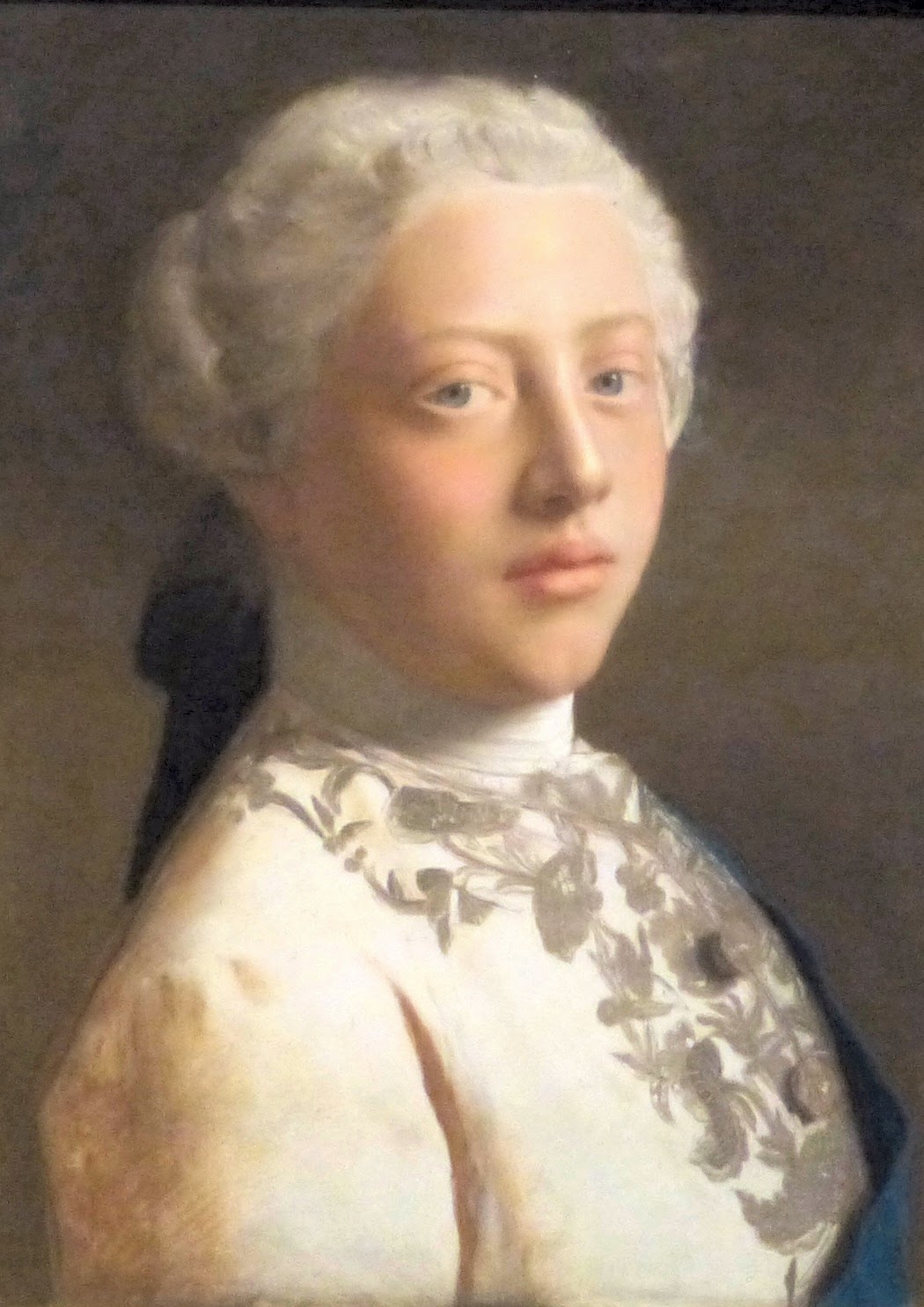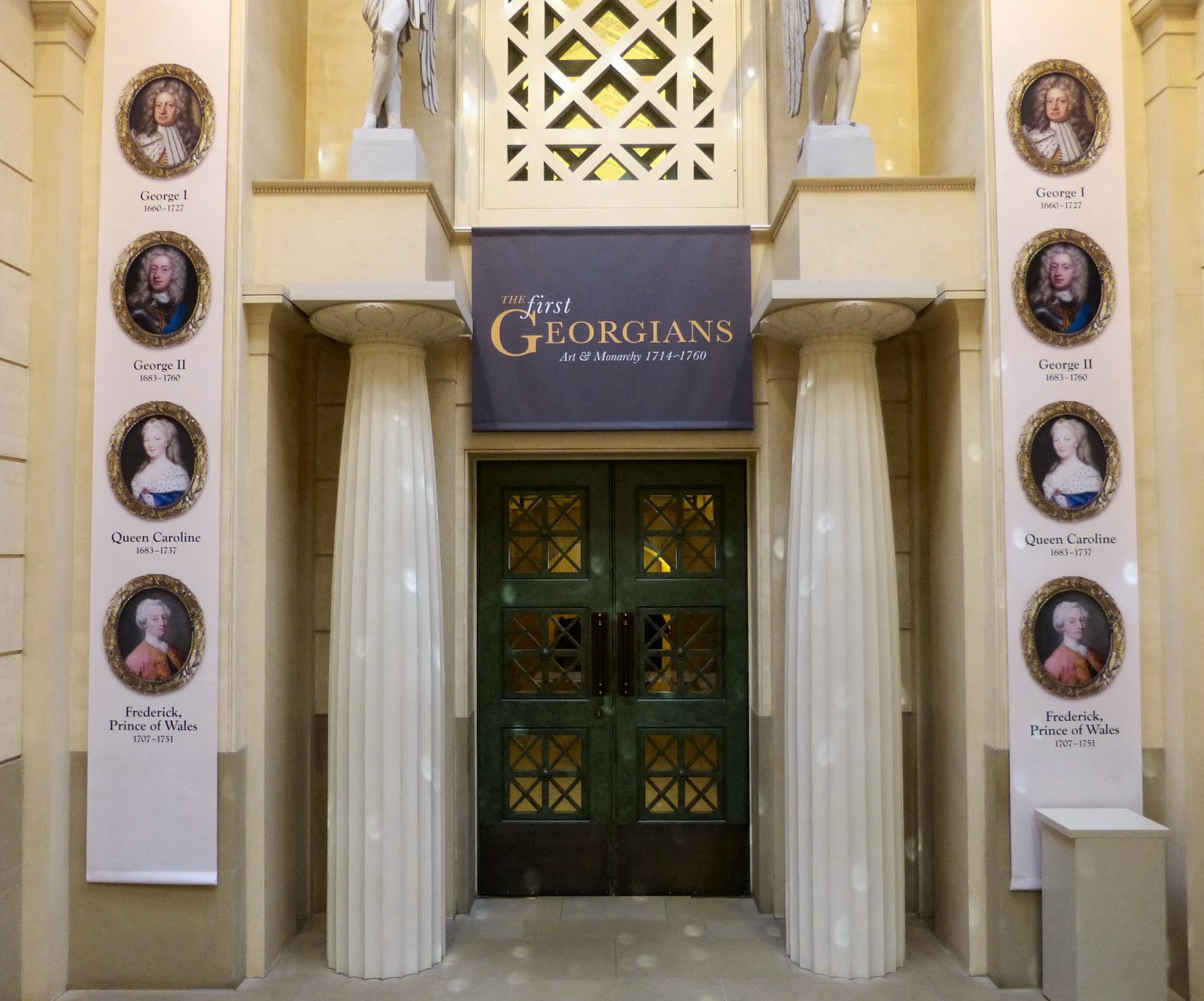The First Georgians – Art & Monarchy 1714-1760 was an exhibition at the Queen’s Gallery, Buckingham Palace, which ran from Friday 11 April to Sunday 12 October 2014.
Why I am blogging about The First Georgians
I was privileged to attend the exhibition preview. But I claim to blog about late Georgian and Regency history, so why am I writing about the First Georgians exhibition which stops in the year that George III became King?
There are two reasons why this exhibition is still relevant. Firstly, the reigns of George I and George II were immediately before that of George III and so set the scene for the late Georgians. What took place in those years shaped the nation that George III became ruler of.
Secondly, George III was born in 1738, and so his formative years took place during the last 22 years of his grandfather George II’s reign.
For those of you that are unfamiliar with the early Georges, here is a very brief introduction:
George I (1714-1727)
 |
| George I by Sir Godfrey Kneller (c1715) (On display in the portrait room) |
The Act of Settlement of 1701 decreed that Great Britain had to be ruled by a Protestant monarch. Accordingly, George I, Elector of Hanover, was proclaimed King on the death of Queen Anne who had no surviving offspring.
George I had two children, George and Sophia, but was no longer married to their mother, Sophia Dorothea. George had divorced and incarcerated his wife for abandoning him when she had eloped with her lover, whose death it was generally believed that he had arranged.
He did not marry again, but had two main mistresses, Ehrengard Melusina von Schulenburg, Duchess of Kendal, and Charlotte Sophia Kielmannsegge, Countess of Darlington.
In 1717, he fell out with his son George so badly that he banished him from the Court. He often visited Hanover and died there unexpectedly in 1727.
George II (1727-1760)
 |
| George II by Sir Godfrey Kneller (1716) - note his wonderful red heels! (On display in Georgian royals, giltware and the Garricks) |
George II was the last British monarch not to be born on British soil. His wife was Caroline of Ansbach, a beautiful and intelligent woman, who was very popular at Court. She embraced the philosophy of the enlightenment, respecting reason above tradition, and was a keen collector of art.
 | |
| Queen Caroline by J Highmore (c1735) (On display in the Portraits room) |
They had four children in Hanover: Frederick, Anne, Amelia and Caroline, and another four in England: George who died in infancy, William, Mary and Louisa.
George II was the last British monarch to lead his troops into battle, which he did at the Battle of Dettingen in 1743.
Like his father, George II quarrelled with his eldest son. He banished Frederick, Prince of Wales, and his wife Augusta from Court in 1737 after a row over the birth of their first child. Frederick had whisked Augusta away from Hampton Court whilst she was in labour to make sure his parents would not be there at the birth. The breach between Frederick and his mother was never healed.
Frederick died in 1751 leaving his eldest son, George, to become King George III in 1760.
The exhibition
The exhibition composes entirely of items from the Royal Collection. It presents us with a snapshot into the lives of the first Georgian Kings: their families and where they lived; the battles they fought and the works of art with which they surrounded themselves.
Portraits
The first room introduces us to the early Georgians with some lovely portraits, including that of Caroline of Ansbach (above) and a pastel of George III by Jean-Étienne Liotard.
 |
| George III by Jean-Étienne Liotard (1754) |
The next three rooms are themed: royal residences, maps and the prints of Hogarth:
Royal residences
This display includes prints of some of the internal rooms of the royal residences, such as the King’s Gallery at Kensington and the Queen’s State Bedchamber at Hampton Court.
 |
| The King's Gallery, Kensington Palace by Charles Wild (c1816) |
The maps were largely collected by William Augustus, Duke of Cumberland, a younger son of George II. He was nicknamed ‘Butcher Cumberland’ because of his ruthless policy against the Jacobite rebels after the Battle of Culloden in 1746.
 |
| Medley drawing by JFC Schilling (1767) It may have been a gift to George III. |
This room includes a selection of prints by Hogarth including The Harlot’s Progress which acted as a comment on the society of the time. This series of prints tells the story of the fall of the harlot, Moll Hackabout, and they were hugely popular in the 1730s.
 |
| The South Sea Scheme by William Hogarth (c1721) |
From the monochrome prints of Hogarth, you pass into the first of the large display rooms, where you are dazzled by colour. The walls are covered with paintings, including several huge pieces by Rubens, collected by the early Georgians and exhibited symmetrically as they would have displayed them.
 |
| Room displaying Old Masters |
There are two tables, beautifully gilded and supported on either side by gilt pedestals which would have held candelabra. The candlelight would have been reflected in the mirrors which would originally have been behind each table to dazzling effect.
One item that particularly caught my interest is a clock. It was bought by Frederick, Prince of Wales, but you have to search to find the clock which is very small compared to the overall size of the piece. In the bottom, there is an organ which plays tunes by Handel.
Miniatures and botanical drawings
Two small chambers off the Old Masters room show displays of royal miniatures and beautifully illustrated books of botany. A further anteroom has a collection of pistols, snuff boxes and other decorative items.
 |
| Botanical drawings by GD Ehret described by CJ Trew (1750-73) |
The second of the two large display rooms is my favourite and contains portraits of all the early Georgians. There is an enormous painting of six of Frederick Prince of Wales’ children, including the eight year old, George III, wielding a bow.
 |
| Detail from painting of Prince Frederick of Wales' children showing the future George III and his brother Edward by Barthélemy du Pan (1746) |
This room also boasts two paintings by Canaletto depicting the River Thames and a table laden with gilt tableware.
 |
| Detail from London: The Thames from Somerset House terrace by Canaletto (c1750) |
One of my favourite works of art on display is the picture of David and Eva Garrick which has been used as the definitive image of the exhibition. I was surprised to discover that this very colourful and cheerful picture was in fact painted by William Hogarth, whom I have always associated with the rather sobering black and white prints displayed in the earlier room.
 |
| David Garrick and his wife, Eva-Maria Veigel by William Hogarth (1757-64) |
 |
| The Millar Learning Room set up as a Georgian coffee shop |
The final room to explore is to the left of the portrait room at the start of the exhibition. This is the Millar Learning Room which has been set up as a Georgian coffee shop. This is an interactive space, particularly good for those with children. There are background noises and ‘windows’ displaying Georgian street scenes. There are bags full of family activities available, short videos playing on a screen set within a picture frame and period hats with headphones, so that you can take in the atmosphere. I really enjoyed visiting the exhibition.
 |
| Me in the Georgian coffee shop |
There are three videos which you can watch online:
Warrior Kings
A King’s Ransom
The Enlightened Queen
and lots more information about the different items on display on the Royal Collection website.
Rachel Knowles writes faith-based Regency romance and historical non-fiction. She has been sharing her research on this blog since 2011. Rachel lives in the beautiful Georgian seaside town of Weymouth, Dorset, on the south coast of England, with her husband, Andrew.
Find out more about Rachel's books and sign up for her newsletter here.If you have enjoyed this blog and want to encourage me and help me to keep making my research freely available, please buy me a virtual cup of coffee by clicking the button below.
Sources used include:
Plumb, JH, The First Four Georges (1956)
Royal Collection website
All photographs © Andrew Knowles Regencyhistory.net



Thank you for alerting me to this exhibition. Definitely looks worth a visit to me!
ReplyDeleteG x
I enjoyed it. I particularly liked the last room which I described as Georgian royals, giltware and the Garricks with the family portrait of George III and his siblings, the Canaletto's and the picture of the Garricks. I hope you get to see it and enjoy it too. :)
DeleteThat's a tempting display! I wish I had time to go... thank you so much for bringing it virtually to my inbox. I confess to being particularly impressed by the pastel picture as I have been known to work in pastels and I'm well aware of the technical limitations of the media which Jean-Etienne Liotard seems to overcome with an aplomb that has me gasping at his virtuosity.
ReplyDeleteGlad you enjoyed it. :) There are two other Liotard pastels of two of George's sisters as well. All three are charming!
DeleteI think I could have spent hours in the display rooms and that botanical book is amazing -- I hope they scan it and make it publicly available. (And you're wearing another gorgeous hat I see)
ReplyDeleteStella Lee
Yes, the botanical book has got such wonderful pictures. It is always frustrating when a book is stuck inside a display cabinet open at a single page, isn't it? As for the hat, perhaps not quite so glamorous...
Delete